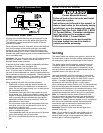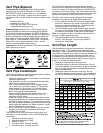
4
Location Requirements
The water heater design has been tested by CSA
International and complies with ANSI Z21.10.1, Section
2.35 Flammable Vapors Resistance. In garage installation
avoid damage to your water heater by installing a vehicle
stop as shown in figure below. Check state and local/
provincial codes for requirements prior to installation.
Important: The water heater should be located in
an area where leakage of the tank or connections will
not result in damage to the area adjacent to the water
heater or to lower floors of the structure. Due to the
normal corrosive action of the water, the tank will
eventually leak after an extended period of time.
Also any external plumbing leak, including those
from improper installation, may cause early failure
of the water tank due to corrosion if not repaired.
A qualified service technician should be contacted
for repairs. A suitable metal drain pan should be
installed under the water heater as shown below, to
help protect the property from damage which may
occur from condensate formation or leaks in the piping
connections or tank. The pan must limit the water level
to a maximum depth of 1-3/4” (4.45 cm) and be at least
two inches (5 cm) wider than the heater and piped to an
adequate drain. Locate the water heater near a suitable
indoor drain. Outside drains are subject to freezing
temperatures which can obstruct the drain line. The
piping should be at least 3/4” (1.91 cm) ID and pitched
for proper drainage. Under no circumstances will the
manufacturer or seller of this water heater be held liable
for any water damage which is caused by your failure to
follow these instructions.
• The water heater should be located in an area not sub-
ject to freezing temperatures. Water heaters located in
unconditioned spaces (i.e., attics, basements, etc) may
require insulation of the water piping and drain piping
to protect against freezing. The drain and controls must
be easily accessible for operation and service. Maintain
proper clearances as specified on the data plate.
Figure 1: Garage Installation
Do not store or use gasoline or other
flammable vapors and liquids in the vicinity
of this or any other appliance. Storage of or
use of gasoline or other flammable vapors
or liquids in the vicinity of this or any other
appliance can result in serious injury or death.
FIRE AND EXPLOSION HAZARD
Can result in serious injury or death
This water heater is not certified for installation in mobile
homes.
Site Location
• Select a location near the center of the water piping
system. The water heater must be installed indoors
and in a vertical position on a level surface. DO NOT
install in bathrooms, bedrooms, or any occupied room
normally kept closed. Note: The water heater may be
installed in a closet with a door off a bedroom or bath-
room providing the units are installed and vented per
the manufacturer’s instructions.
• Consider the inlet and exhaust vent system piping
when selecting the water heater location. The venting
system must be able to run from the water heater to
the termination with a minimal length and number of
elbows. Input rates are reduced as vent system length
increases. The venting system must comply with the
requirements set forth in the venting section of this
manual.
• Locate the water heater near the existing gas piping.
If installing a new gas line, locate the water heater to
minimize the pipe length and elbows.
Important: Air for combustion and ventilation must not
come from a corrosive atmosphere. Any failure due to cor-
rosive elements in the atmosphere is excluded from war-
ranty coverage.
Note: The water heater must be installed according to all
state and local/provincial codes or in absence of the state
and local/provincial codes with the “National Fuel Gas
Code”, ANSI Z223.1 (NFPA 54)-current edition. Canadian
installations must be performed in accordance with CAN/
CSA-B149.1-current edition.
1-3/4” (4.45 cm) Max.
(5 cm)
Figure 1A


















